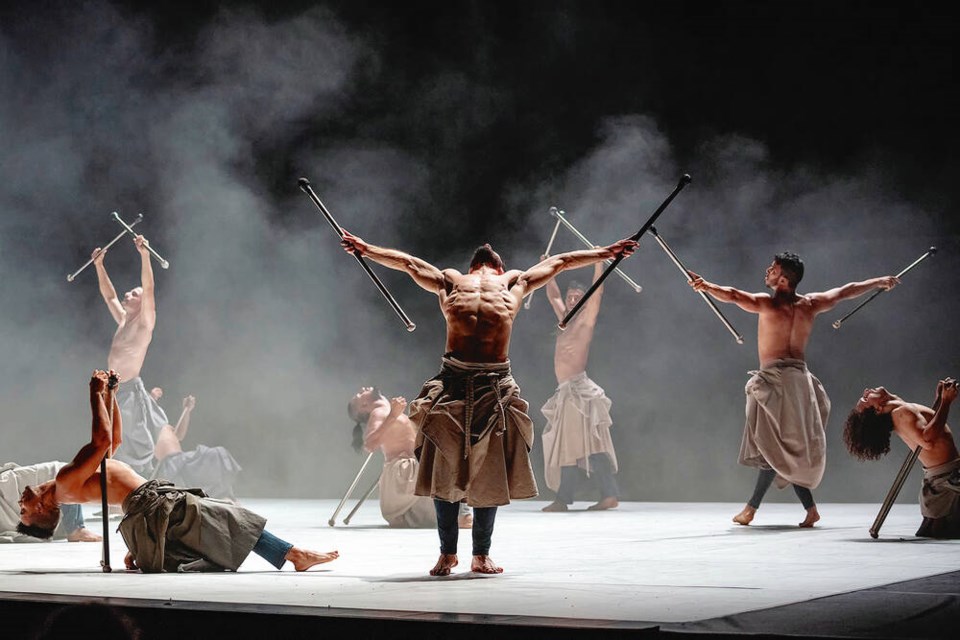The whirling-dervish dance of Compagnie Hervé Koubi likely still spins in the minds of the lucky folk who experienced it this weekend at the Royal Theatre.
When it comes to sheer gymnastics this troupe has it all. On Friday and Saturday audiences witnessed bravura head-spinning, backflips, hand-stand spins, and somersaults. It’s dance, certainly — but dance of a singularly acrobatic variety. Compagnie Hervé Koubi shrugs off the vocabulary of traditional ballet in favour of gravity-defying movement that’s simultaneously ecstatic, exultant and deeply human.
The Calais-based company, making its debut in here via Dance Victoria, consists of 13 male street dancers from Algeria, France, Morocco and the west African country of Burkina Faso. The company was assembled by artistic director Hervé Koubi, who choreographed the 65-minute piece performed here: The Barbarian Nights (or The First Dawns of the World).
Koubi’s an interesting guy. He grew up in France where he studied to be a pharmacist before turning to a career in dance. His life changed when he was 25. His father revealed a family secret; Koubi was of Algerian descent, which in his country is equated by some with lower-class status.
“It was a shock for me. I was not from France, but Arabic,” said Koubi, a lanky fellow in jeans who addressed the Victoria audience Friday night.
A sense of cultural alienation led to the creation of The Barbarian Nights. Koubi said his use of the word “barbarian” in part connotes the trepidation some feel upon encountering outsiders. His artistic purpose is quite the opposite — The Barbarian Nights is intended to celebrate and humanize the rich and diverse mix of cultures found in the Mediterranean region.
Koubi’s street dancers were auditioned in North Africa. Their style is influenced by hip-hop, acrobatics, contemporary dance and such martial art forms as the Brazilian capoeira.
In The Barbarian Nights the troupe entered naked from the waist up, wearing glittering horned bull masks. While dancers tend to be in great shape, these particular performers looked like uber-jacked advertisements for some cutting-edge workout program. They’re tall and wide-shouldered, seemingly without an ounce of fat, every rib and muscle well defined.
The low lighting — coming mostly from overhead and stage right — emphasized their physiques. The overall effect was deliberately sculptural; watching The Barbarian Nights is like seeing Italian renaissance statues magically explode into life.
The bull masks were eventually removed. The dancers, wearing jeans and sarong-style costumes, then brandished sabres that clanged against one another. These were finally exchanged for acrobat batons, a pair for each performer. These were balanced to form a T shape; elsewhere the dancers used sticks to pole-vault across the stage.
It was gymnastic feats that most astonished — I’ve never experienced anything quite like it. One dancer (with an impressive Afro) spun upside-down like a top on one arm. He and other performers did hip-hop-style headspins that were executed flawlessly. Remarkably, one continued for at least 50 revolutions before I lost count.
The Barbarian Nights is set to snippets of Mozart, Fauré, Wagner as well as traditional music from Algeria and the Eastern European country of Georgia. It’s a diverse mix: orchestral, choral, percussive. Odd sounds are occasionally dropped in, for instance, a repeated ting that sounded like a spoon striking a metal bar. The overarching effect was of big layers of sound — rumbling, echoing, sometimes ominous in a post-apocalyptic way, elsewhere joyful and redemptive.
When the elements are described separately it may sound like a diverse grab-bag of tricks. It’s not. Koubi’s managed to create an artwork that’s surprisingly cohesive, especially so given its length (although towards the end there is a sense of repetition).
There are peaks and valleys, shifts between loud and soft, interludes of both frenzy and lyricism. Sometimes the entire troupe undulated like one writhing organism only to give way to a simple pas de deux. In one notable sequence, sabre-wielding dancers surrounded a man as he stared blankly into the audience as though resigned to his fate.
I recall years ago visiting Paris and seeing African street dancers perform outside the Notre Dame Cathedral. A crowd gathered to applaud their hip-hop pyrotechnics and gymnastic exploits. Barbarian Nights reminds me of that, yet this work transcends mere crowd-pleasing gimmickry. We’re ultimately left with something more profound, the sense that there’s beauty in diversity and humanity, that this is something that can be celebrated.



